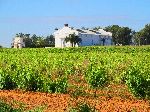|
Morocco:
West Atlas Bicycle Africa / Ibike Tours |
|||
 |
Western Atlas: Forêt de la Maamora, Tiflet, and Khemisset | ||
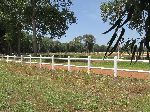 |
Leaving Rabat-Salé to the interior, after
ever expanding suburbs of Salé, the land use
gets increasing more rural. Along the way you pass some royal enclosures (not to be photographed) and
an extensive sports area for the Moroccan Royal Arm Forcs (also not photographed) that include a large
equestrian training facility with a very nicely maintained white rail fence. The expectations for the local cows are not so high so they can pass the day grazing, and can be photographed. |
 |
|
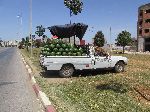 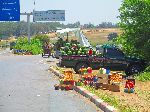 Along
the highway, approaching Sidi Allal el
Bahraoui, there are pop-up produce stands -- many set in the bed of pick-up
trucks.. It looks like this visit was in
watermelon season, but there were also a few other fruits being sold like
oranges and peaches. Along
the highway, approaching Sidi Allal el
Bahraoui, there are pop-up produce stands -- many set in the bed of pick-up
trucks.. It looks like this visit was in
watermelon season, but there were also a few other fruits being sold like
oranges and peaches. |
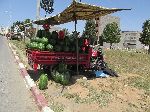 |
||
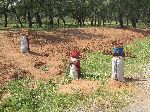
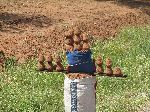 Curiously, another item stacked up for sale along the road were truffles. But on
realizing that we were passing through a corner of a cork-oak forest, this made
more sense. Apparently truffles grow near the roots of cork-oak as well as other
trees. The truffles were packaged (preserved) in balls of clay. It seems that
this would make it difficult to determine exactly how large the truffles was,
and hence its value.
Curiously, another item stacked up for sale along the road were truffles. But on
realizing that we were passing through a corner of a cork-oak forest, this made
more sense. Apparently truffles grow near the roots of cork-oak as well as other
trees. The truffles were packaged (preserved) in balls of clay. It seems that
this would make it difficult to determine exactly how large the truffles was,
and hence its value. |
|||
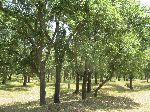 |
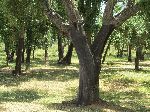 Inland from Rabat-Sale and Kenitra Sali is the large Forêt de la Maamora, a cork-oak forest. It is the largest cork oak forest in Morocco and probably the world. A century earlier is was 130,000 hectors (1300 sq km), but by the new millennium, from human encroachment, it had been reduced to 55,000 hectors (550 sq km). Much of what is left is roadless (there are trails and tracks), but there is a paved road that circles through the southeast corner. |
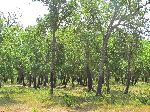 |
|
| The low traffic volume road is popular with local cyclists. I was invited to join cycling group on a training ride going this way -- they were very patient not to drop me. | |||
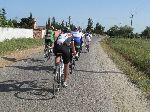
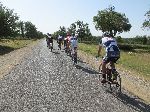
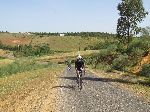
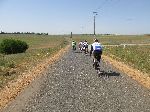 |
|||
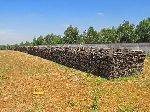
 Maamora forest is being actively managed and harvested.. The first bark from a
cork-oak can be harvested at about 25 years, then they can be harvested every 9
years, until the tree is about 150 years old. After the bark is harvested is
stacked in a prescribed manner, and seasoned for not less than six months.
Maamora forest is being actively managed and harvested.. The first bark from a
cork-oak can be harvested at about 25 years, then they can be harvested every 9
years, until the tree is about 150 years old. After the bark is harvested is
stacked in a prescribed manner, and seasoned for not less than six months. |
|||
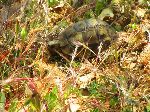
 There
is a sign about a project to rehabilitate the Maamora cork-oak forest. There
were a couple of large patches of eucalyptus trees that have been clear cut. In
one of these there was a charcoal making operation. Time will tell if it
replanted in cork-oak. There
is a sign about a project to rehabilitate the Maamora cork-oak forest. There
were a couple of large patches of eucalyptus trees that have been clear cut. In
one of these there was a charcoal making operation. Time will tell if it
replanted in cork-oak.The small tortoise (right) was found in the middle of the road and relocated to the side. He happily crawled on. |
|||
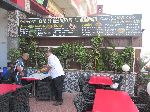 This
is a typically
roadside restaurant, with a typical menu, in Sidi Allal el
Bahraoui. The menu lists Moroccan salad and soup, grilled meats, several kinds
of tagines (meat and vegetables steamed in a thick ceramic tagine dish), roasted
chicken and drinks. Another frequent menu item at casual dinning restaurants is
pizza. This
is a typically
roadside restaurant, with a typical menu, in Sidi Allal el
Bahraoui. The menu lists Moroccan salad and soup, grilled meats, several kinds
of tagines (meat and vegetables steamed in a thick ceramic tagine dish), roasted
chicken and drinks. Another frequent menu item at casual dinning restaurants is
pizza. |
|||
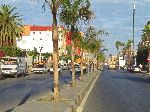
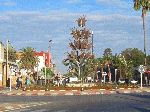 Tiflet is a growing town with a newly upgraded main street. One of the traffic circles has what, by day, is a fairly non-descript sculpture (right). If you return at night it transforms into a colorful pomegranate flower (far right). The symbol of the town might be the pomegranate, but the identity of the town has got to be the café. There must be a dozen with in 100m of the traffic circle. A few of these are shown below. |
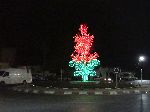 |
||
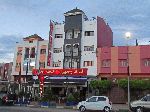 |
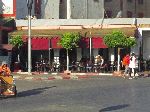
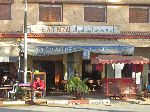
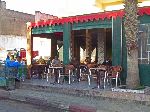
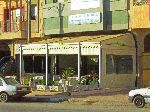 |
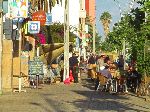 |
|

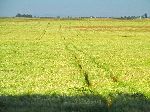 Agriculture in Morocco often seem to be "as far as the eye can see", as in
olives as far as the eye can see, or argan as far as the eye can see, or as in
this series of pictures, wheat for as far as the eye can see.
Agriculture in Morocco often seem to be "as far as the eye can see", as in
olives as far as the eye can see, or argan as far as the eye can see, or as in
this series of pictures, wheat for as far as the eye can see. |
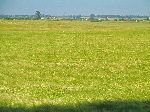 |
||
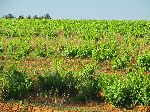
The wheat fields are occasionally interrupted by some other crop -- in this case grape. The large white building seems to be associated with the vineyard. On closer inspection the roof of the building is dotted with white stork nests. These storks add on to existing nest, so over time they can become huge. The presence of storks is loved so nesting is encouraged and nesting sites never disturbed. |
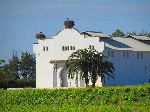 |
||
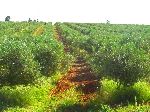 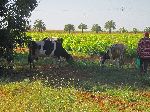 There is also a smattering of other agricultural activities, like olives (left) and cattle (right). It is all scenic. There were also a few small orchards of pomegranate, but they were always behind high hedgerows so difficult to photograph distinctly. |
|||
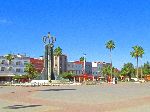   A prominent feature of Khemisset is its central square. Generally, it is very open, but accented with dozen of very tall Royal Palms, a couple of sculptures and a few other structures. |
|||
 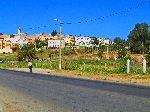 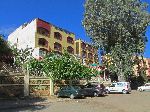 Elsewhere
the town was similar to others, with markets, a few taller buildings and
sprawling housing. Elsewhere
the town was similar to others, with markets, a few taller buildings and
sprawling housing. |
|||
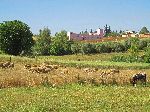 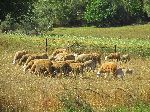 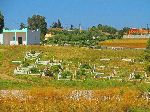 On
the outskirts of town, a flock of sheep were grazing (left) and there is a
cemetery (right). On
the outskirts of town, a flock of sheep were grazing (left) and there is a
cemetery (right). |
|||
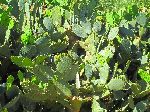 |
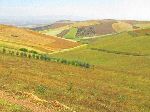
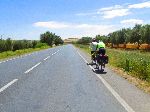
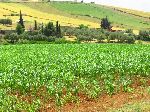
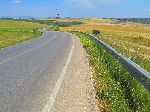 |
 |
|
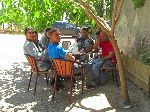 The 60km
(37 miles) of road between Khemisset and Meknes continues to be scenic and
varied (row above). In new abundance in this section were prickly-pear cactus
and corn, both of which were introduced from the New World. The 60km
(37 miles) of road between Khemisset and Meknes continues to be scenic and
varied (row above). In new abundance in this section were prickly-pear cactus
and corn, both of which were introduced from the New World.Unlike in the towns, cafés are sparse, but we found a welcoming one where we needed it (right). |
|||
|
|
|||
|
|
Unique Programs To Special Places For Memories Of A Lifetime!
"Hosted by
DreamHost - earth friendly web hosting"
|
|
